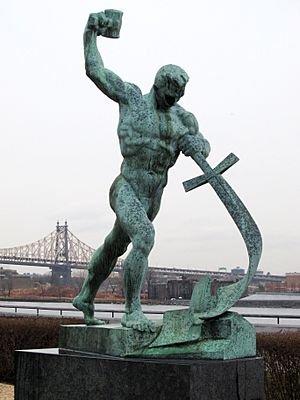Disarmament facts for kids
Disarmament means reducing or getting rid of weapons. It can also mean limiting how many weapons a country has. This idea often refers to a country's entire military or specific types of weapons. A big goal of disarmament is to completely remove weapons of mass destruction (WMDs), like nuclear bombs.
The United Nations (UN) has a plan called "General and Complete Disarmament." This plan aims to get rid of all WMDs. It also wants to reduce regular armies and weapons in a balanced way. The main idea is to make sure all countries still feel safe. This helps create more peace and stability around the world.
Contents
Why is Disarmament Important?
Disarmament is important for several reasons. It helps prevent wars and makes the world safer. When countries have fewer weapons, especially very powerful ones, there is less risk of big conflicts. It also means countries can spend less money on weapons. This money can then be used for things like education, healthcare, or fighting poverty.
Keeping the Peace
One main goal of disarmament is to keep the peace. When countries agree to reduce their weapons, it builds trust between them. This trust can help solve problems through talks instead of fighting. It also lowers the chance of an accidental war starting.
Saving Resources
Building and keeping weapons is very expensive. Disarmament allows countries to save a lot of money. This money can be used to improve the lives of people. For example, it can fund schools, hospitals, or projects that protect the environment.
Types of Disarmament
Disarmament can happen in different ways. It can be about getting rid of all weapons or just certain kinds.
Weapons of Mass Destruction
The most serious type of disarmament focuses on WMDs. These are weapons that can kill many people at once. They include nuclear, chemical, and biological weapons. Many countries work together to try and get rid of these dangerous weapons.
Nuclear Disarmament
Nuclear disarmament is about reducing or eliminating nuclear weapons. These are the most powerful and destructive weapons ever made. Countries with nuclear weapons often sign treaties. These treaties aim to limit how many nuclear weapons they have. They also try to stop other countries from getting them.
Conventional Disarmament
This type of disarmament deals with regular weapons. These include guns, tanks, planes, and ships. Countries might agree to limit the size of their armies. They might also limit the number of certain weapons they own. An example is the Washington Naval Treaty from 1922. This treaty limited the number of large warships that powerful countries could have.
How Disarmament Happens
Disarmament usually happens through agreements between countries. These agreements are called treaties or conventions.
Treaties and Agreements
Countries sign treaties where they promise to reduce or not use certain weapons. For example, the Treaty on the Non-Proliferation of Nuclear Weapons (NPT) tries to stop the spread of nuclear weapons. It also encourages countries to work towards nuclear disarmament.
Verification and Trust
For disarmament to work, countries need to trust each other. They also need ways to check if everyone is following the rules. This is called verification. International organizations, like the UN, often help with this. They send inspectors to make sure weapons are being destroyed or reduced as agreed.
Challenges to Disarmament
Disarmament is not always easy. There are many challenges that countries face.
Trust and Security Concerns
Countries might worry about their safety if they give up weapons. They might fear that other countries will not follow the rules. Building trust between nations is a big part of making disarmament work.
Technology and New Weapons
New technologies can create new types of weapons. This makes disarmament an ongoing challenge. Countries need to keep talking and making new agreements as technology changes.
Images for kids
-
Battleships being dismantled for scrap in Philadelphia Navy Yard, after the Washington Naval Treaty imposed limits on capital ships
-
Martin Kobler addresses attendees at a disarmament ceremony in Goma, Democratic Republic of Congo
-
Workers cut launch tubes for nuclear missiles as part of the Cooperative Threat Reduction program.
See also
 In Spanish: Desarme y control de armamento para niños
In Spanish: Desarme y control de armamento para niños





